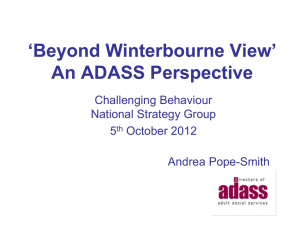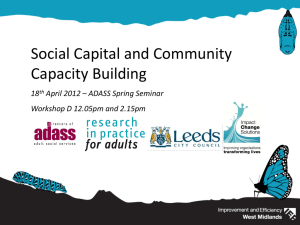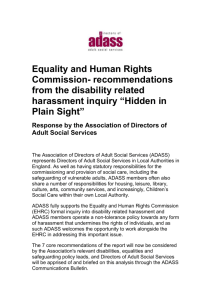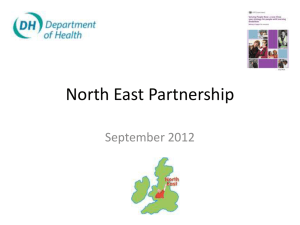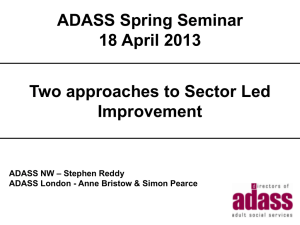Talk given to the ADASS 2005 conference in Oct 2005
advertisement
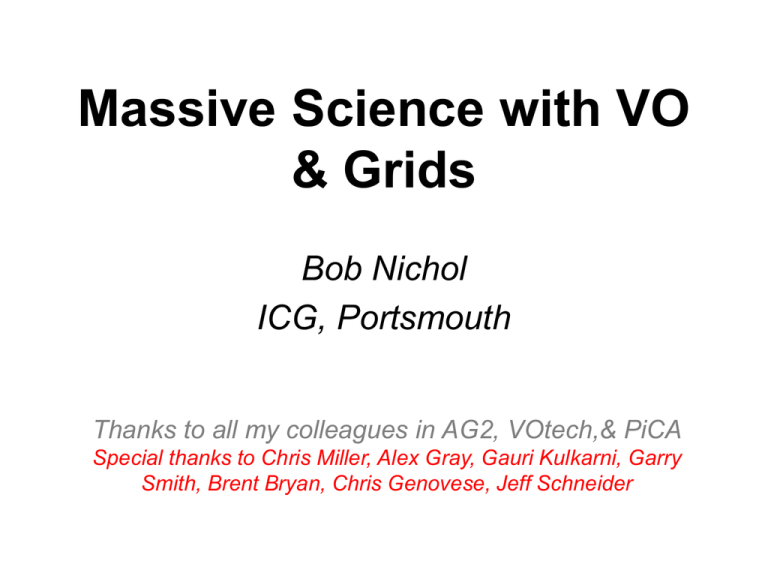
Massive Science with VO & Grids Bob Nichol ICG, Portsmouth Thanks to all my colleagues in AG2, VOtech,& PiCA Special thanks to Chris Miller, Alex Gray, Gauri Kulkarni, Garry Smith, Brent Bryan, Chris Genovese, Jeff Schneider Outline 1. VO + Grid provides a powerful emerging infrastructure for massive scientific calculations 2. Discussion of VO infrastructure and VOtechbroker 3. Examples: • N-point correlation functions • Nonparametric analyses and massive model fitting ADASS 2005 2 + QuickTime™ and a TIFF (Uncompressed) decompressor are needed to see this picture. Quic kTime™ and a TIFF (Unc ompres sed) dec ompres sor are needed to see this pic ture. QuickTime™ and a TIFF (U ncompressed) decompressor are needed to see t his picture. QuickTime™ and a TIF F (Uncompressed) decompressor are needed to see this picture. ADASS 2005 3 Euro-VO • The Euro-VO Data Centre Alliance (DCA): – A collaborative and operational network of European data centres who publish data and metadata to the Euro-VO and who provide a research infrastructure of GRID-enabled processing and storage facilities. • The Euro-VO Facility Centre (VOFC): – An organization that provides the Euro-VO for centralized resource registry, standards definition and promotion as well as community support for VO technology take-up and scientific program support using VO technologies and resources. • The Euro-VO Technology Centre (VOTC) – A distributed organisation that coordinates a set of research and development projects on VO technology, systems and tools. ADASS 2005 4 EuroVO: VOTech Project • Aims: – Complete all technical preparatory work necessary for the construction of the European Virtual Observatory, – Responsible for development of infrastructure and tools: • Intelligent resource discovery (ontology and the semantic web), data interoperability, data mining, and visualisation capabilities. – Provide the ability to offload mass scale computational process onto the Enabling Grids for E-sciencE (EGEE) backbone. ADASS 2005 5 Existing infrastructure • VOTech is tasked with building upon existing infrastructure: –IVOA for standards –AstroGrid for middleware • Web Services based, • Presumably IVOA will continue to look towards other standards bodies: –World Wide Web Consortium (W3C) –Global Grid Forum (GGF) ADASS 2005 6 IVOA Standards VOTable Format Definition Version 1.1: – An XML language, • Flexible storage and exchange format for tabular data: Emphasis on astronomical tables, – Allows meta data and data to be stored separately with links to remote data. • Resource Metadata for the VO Version 1.01: – For describing what data and computational facilities are available, and once identified how to use them. • Unified Content Descriptor (UCD) (Proposed): – A formal (and restricted) vocabulary for astronomical data. • IVOA Identifiers Version 1.10 (Proposed): – Syntax for globally unique resource names. ADASS 2005 7 AstroGrid Components • MySpace: Distributed file store for workflows,results, • Common Execution Architecture (CEA): – Codes need wrapping before use, – Take command line apps and present as a Web Service. • Algorithm Registry: – Meta data from wrapped codes are published in a yellow pages, for searching. • Portal: – Web interface for interacting with preceding services, – Workflow: Coordinate data flow/control of components within a larger system of work, – Submit jobs and observe status, and access files in MySpace. • Dashboard/Workbench: – Interact with MySpace, Registry, CEA from any language that provides XML-RPC library. Web Start application. ADASS 2005 8 AG rollout and access via portal AG Portal ADASS 2005 9 VOtechbroker • Execute potentially thousands of sequential processes simultaneously, repeat multiple times: – Parameter sweep. • Utilise existing infrastructure at remote sites: – e.g. computational resources: Condor, Globus, – Transparent to the user. • Locate suitable compute nodes (i.e. processor type, available libraries, CPU load, memory, • Stage code and observe status of running processes, • Combine results for further analysis, e.g as input to a post-mortem visualisation component in the AG workflow. ADASS 2005 10 London eScience Center GGF Architecture Job Submission Description Language (JSDL) from the Global Grid Forum AstroGrid ADASS 2005 13 Web form ADASS 2005 14 Broker Summary • A broker to submit parameter sweeps to the Grid, and other distributed resources, in a transparent way, • Aim to allow arbitrary algorithms to be added easily, just a new web form • Aim to interoperate with a wide range of job submission systems using a plug-in system, • Distributed architecture based on Web Services, allows for multiple types of client, • AstroGrid workflow important: – CEA command line to thin algorithm wrappers, – Wrapper and Broker interaction with MySpace. • X.509 and myproxy for authentication/authorisation. • Ready for full-scale testing: n-point functions ADASS 2005 19 N-point Correlation Functions The 2-point function ((r)) has a long history in cosmology (Peebles 1980). It is the excess joint probability (dP12) of a pair of points over that expected from a Poisson process. dP12 = n2 dV1 dV2 [1 + (r)] dV1 r dV2 dP123=n3dV1dV2dV3[1+23(r)+13(r)+12(r)+123(r)] Measure of the topology of the large-scale structure in universe Credit: Alex Szalay Same 2pt, different 3pt Multi-resolutional KD-trees • Scale to n-dimensions • Use Cached Representation (store at each node summary sufficient statistics). Compute counts from these statistics • Prune the tree which is stored in memory • (Moore et al. 2001 astro-ph/0012333) Top Level 1st Level 2nd Level 5th Level Just a set of range searches Also Prune cells inside! Greater saving in time Prune cells outside range Dual Tree Algorithm N1 dmax Usually binned into annuli rmin< r < rmax dmin Thus, for each r transverse both trees and prune pairs of nodes N2 No count dmin < rmax or dmax < rmin Therefore, only need to calculate pairs cutting the boundaries. Scales to n-point functions also do all r values at once N1 x N2 rmin > dmin and rmax< dmax ADASS 2005 25 3-point Correlation Function of SDSS Luminous Red Galaxies Details of the dataset: 0.15 < z < 0.55 -23.2 < Mg < -21.2 (~50000 LRGs from Eisenstein et al. 2005) Each bin can be 100’s of individual calculations (errors) ADASS 2005 26 Employing npt on Teragrid - I • Scale of computing npt: – For the value of 2-point correlation function within any give bin, we need 3 types of pair counts (DD, DR and RR) while for the value of 3-point correlation function, we need 4 types of triplet counts (DDD, DDR, DRR, RRR). – Memory requirement depends upon the size of the dataset and random catalog. For ~50,000 LRGs and random dataset of ~800,000 ,NPT code makes a tree of ~50MB. – Each bin requires error estimate, which can mean 30 jackknifes: Therefore, each bin can be hundreds of individual jobs which can be sent to a separate node ADASS 2005 27 1.5 < s < 2.5 Mpc/h 0.5 < s < 1.5 Mpc/h Time (sec) 0.5 < s < 1.5 Mpc/h Time (sec) Time (sec) Employing npt on Teragrid - II 9.5 < s < 10.5 Mpc/h 19.5 < s < 20.0 Mpc/h 9.5 < s < 10.5 Mpc/h 1.5 < s < 2.5 Mpc/h 19.5 < s < 20.0 Mpc/h / (radian) /(radian) (radian) / Time taken on TeraGrid to compute DDD triplets for LRG data. Time taken on TeraGrid to compute RRR triplets. ADASS 2005 28 Employing npt on Teragrid - III • Limitations: – Long queue time (stretching sometimes to 6 hours). – After 24 hrs, jobs are terminated. So bigger datasets need to be processed on different cluster. ADASS 2005 29 Non-parametric techniques • The complexicity and wealth of the data demands non-parametric techniques, ie., can one describe phenomena using the least amount of assumptions? ADASS 2005 30 CMB Power Spectrum Before WMAP WMAP data Are the 2nd and 3rd peaks detected? ADASS 2005 31 In parametric models of the CMB power spectrum the answer is likely “yes” as all CMB models have multiple peaks. But that has not really answered our question! Can we answer the question non-parametrically e.g., Yi = f(Xi) + ci Where Yi is the observed data, f(Xi) is an orthogonal function (icos(iXi)), ci is the covariance matrix. The challenge is to “shrink” f(Xi), we use • Beran (2000) to strink f(Xi) to N terms equal to the number of data points - optimal for all smooth functions and provides valid confidence intervals • Monotonic shrinkage of i - specifically nested subset selection (NSS) See Genovese et al. (2004) astro-ph/0410104 ADASS 2005 32 Results (optimal smoothing through bias-variance trade-off) Concordance Our f(Xi) Note, WMAP only fit is not same as concordance model ADASS 2005 33 Testing models • The main advantage of this method is that we can construct a “confidence ball” (in N dimensions) around f(Xi) and thus perform non-parametric interferences e.g. is the second peak detected? Not at 95% confidence! ADASS 2005 34 Gray are models in the 95% confidence ball ASA “Outstanding Application of the year” (2005) Using CMBfast we can make parametric models (11 parameters) and test if they are within the “confidence ball”. Varying b we get a range of 0.0169 to 0.0287 ADASS 2005 35 Testing in high D • Now we can now jointly search 7 cosmological parameters in the parametric model and determine which models fit in the confidence ball (at 95%). • Traditionally this is done by marginalising over the other parameters to gain confidence intervals on each parameter separately. This is a problem in highD where the likelihood function could be degenerate, ill-defined and under-identified • This is computational intense as millions of models need to searched, each takes ~3 minute to run ADASS 2005 36 Find boundaries We using kriging – – – “method of interpolation which predicts unknown values from data observed at known locations” Also known as Gaussian process regression; a form of Bayesian inference Different metrics for evaluation (Variance, Entropy, least probable) Variance: pick points far from other searches Straddle: points far from other searches and near predicted boundary ADASS 2005 37 50 samples ADASS 2005 200 samples 38 Results baryons Add two heuristics: • Path - explore between peaks • Depth - flood peaks darkmatter ADASS 2005 39 Purple: 68% Red: 95% 1.2 million models 6.8yrs of CPU Time ADASS 2005 40 Future • Marriage with VOtechbroker and run 10 million models on TeraGrid (300Gb of models) • Java code exists to query dataspace provide a webservice • Add other data (CMB, LSS) • Convergence test: shape of surface • Visualization of 7D space ADASS 2005 41 Future applications • Selection function for XMM Cluster Survey • Add fake clusters and then analyse • Over a million combinations, or 4 yrs of CPU time Fake cluster added to XMM field ADASS 2005 42 Summary • VO infrastucture with emerging Grids provides a powerful framework within which to do massive calculations • VOtechbroker will abstract Grid from user and interface with VO mySpace • Registry of advanced algorithms (npt, kriging, nonparametric statistics etc.) ADASS 2005 43
